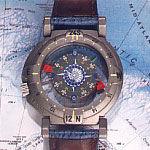
IMMARSAT satellite (London, England) – Satellite communication
South Pole expedition – Antarctica, 1996
Bernard Voyer used satellite technology on his Antarctic expedition and proved that it was possible to communicate by telephone via a geostationary satellite past the 85th parallel, i.e. 170 km farther than the most optimistic predictions by experts worldwide.
Argos beacons (Toulouse, France)
South Pole expedition – Antarctica, 1996
Development of a computer system capable of managing data from an Argos beacon that transmitted a signal every two minutes to two geostationary satellites located 8,000 m above the South Pole at 100-minute intervals. The system was used to decode data on the expedition members’ position and their physical and mental condition, the type of terrain and how many kilometres they had covered. The signal transmitted by the beacon was relayed to Toulouse, France and then retransmitted to Montreal, so that the explorers could be tracked in real time on a map of Antarctica over the Internet.
Composite materials, clothing and shoes
A number of Canadian firms used Bernard Voyer’s experiences under extreme conditions during his expeditions to develop technical expertise in using composite materials. The Canadian garment and shoe industry and the Canadian Fur Council also seized this extraordinary opportunity to test and design new models and materials, helping them to develop garments better suited to our severe weather.
